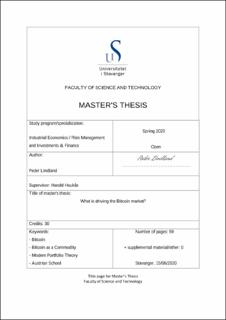| dc.contributor.advisor | Haukås, Harald | |
| dc.contributor.author | Lindland, Peder | |
| dc.date.accessioned | 2020-10-12T13:44:56Z | |
| dc.date.available | 2020-10-12T13:44:56Z | |
| dc.date.issued | 2020-06 | |
| dc.identifier.uri | https://hdl.handle.net/11250/2682299 | |
| dc.description | Master's thesis in Industrial Economics. | en_US |
| dc.description.abstract | The Bitcoin market has grown to become relevant to financial markets and there are still a number of unanswered questions relating to Bitcoin as an asset class and how the Bitcoin market behave relative to traditional financial markets. The aim of the thesis is to further investigate the technological and financial properties of Bitcoin and disclose how these relate to the Bitcoin market and the broader aspects of the financial world. The topic of interest is formulated into a set of research questions.
RQ1: “What is driving the Bitcoin market?”
RQ2: “How does the future look like for the Bitcoin market?”
The thesis answers the research questions of interest by a set of different quantitative analyses in combination with existing economic theory, models, and economic thoughts. The quantitative analyses conducted for the thesis are a cost of production analysis of Bitcoin, a set of regression analyses and a portfolio analysis. The data retrieved for the different analyses is carefully inspected and retrieved from trusted sources. The aspects of modern portfolio theory in terms of diversification and hedging properties is essential for the thesis. In addition, the economic thoughts of the Austrian School are reasonably weighted in the discussion and the concluding remarks in order to answer the set of research questions.
The technological and financial properties of Bitcoin reveal that the supply side is fixed, and the demand side is ultimately the most important factor driving the Bitcoin market. The findings of the cost of production analysis reveal a significant relationship between the Bitcoin spot price and underlying fundamental cost of production and correspondingly Bitcoin tend to gravitate towards the production cost, likewise other commodities. The set of regression analyses supports the significant relationship between the Bitcoin spot price and underlying fundamental cost of production.
Finally, the results of the portfolio analysis reveal Bitcoin as great diversifier in terms of low correlation to a number of other assets and indices. The concluding remarks of the thesis covers that the demand in the Bitcoin market is expected to increase, given that regulation is fully set, as the properties of Bitcoin is presumably equal to gold and given the existing uncertainty in the financial markets. | en_US |
| dc.language.iso | eng | en_US |
| dc.publisher | University of Stavanger, Norway | en_US |
| dc.relation.ispartofseries | Masteroppgave/UIS-TN-ISØP/2020; | |
| dc.subject | industriell økonomi | en_US |
| dc.subject | kryptovaluta | en_US |
| dc.title | What is driving the Bitcoin market? | en_US |
| dc.type | Master thesis | en_US |
| dc.description.version | submittedVersion | en_US |
| dc.subject.nsi | VDP::Teknologi: 500 | en_US |
| dc.subject.nsi | VDP::Samfunnsvitenskap: 200::Økonomi: 210 | en_US |
